计量经济学课后题答案
计量经济学习题及参考答案解析详细版
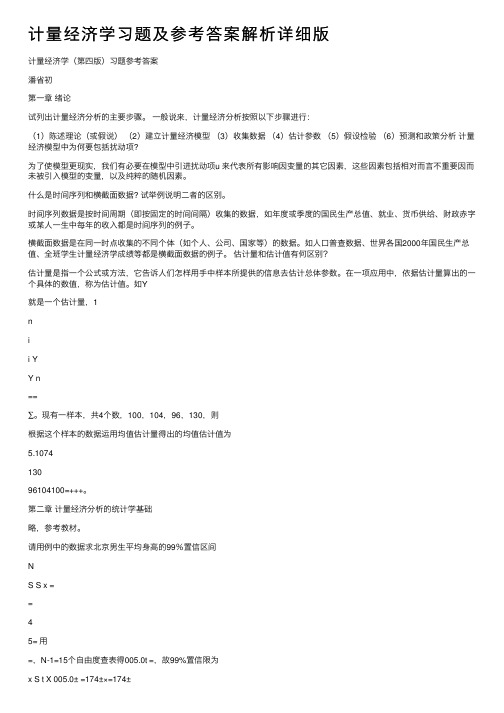
计量经济学习题及参考答案解析详细版计量经济学(第四版)习题参考答案潘省初第⼀章绪论试列出计量经济分析的主要步骤。
⼀般说来,计量经济分析按照以下步骤进⾏:(1)陈述理论(或假说)(2)建⽴计量经济模型(3)收集数据(4)估计参数(5)假设检验(6)预测和政策分析计量经济模型中为何要包括扰动项?为了使模型更现实,我们有必要在模型中引进扰动项u 来代表所有影响因变量的其它因素,这些因素包括相对⽽⾔不重要因⽽未被引⼊模型的变量,以及纯粹的随机因素。
什么是时间序列和横截⾯数据? 试举例说明⼆者的区别。
时间序列数据是按时间周期(即按固定的时间间隔)收集的数据,如年度或季度的国民⽣产总值、就业、货币供给、财政⾚字或某⼈⼀⽣中每年的收⼊都是时间序列的例⼦。
横截⾯数据是在同⼀时点收集的不同个体(如个⼈、公司、国家等)的数据。
如⼈⼝普查数据、世界各国2000年国民⽣产总值、全班学⽣计量经济学成绩等都是横截⾯数据的例⼦。
估计量和估计值有何区别?估计量是指⼀个公式或⽅法,它告诉⼈们怎样⽤⼿中样本所提供的信息去估计总体参数。
在⼀项应⽤中,依据估计量算出的⼀个具体的数值,称为估计值。
如Y就是⼀个估计量,1nii YY n==∑。
现有⼀样本,共4个数,100,104,96,130,则根据这个样本的数据运⽤均值估计量得出的均值估计值为5.107413096104100=+++。
第⼆章计量经济分析的统计学基础略,参考教材。
请⽤例中的数据求北京男⽣平均⾝⾼的99%置信区间NS S x ==45= ⽤也就是说,根据样本,我们有99%的把握说,北京男⾼中⽣的平均⾝⾼在⾄厘⽶之间。
25个雇员的随机样本的平均周薪为130元,试问此样本是否取⾃⼀个均值为120元、标准差为10元的正态总体?原假设120:0=µH备择假设 120:1≠µH 检验统计量()10/2510/25XX µσ-Z ====查表96.1025.0=Z 因为Z= 5 >96.1025.0=Z ,故拒绝原假设, 即此样本不是取⾃⼀个均值为120元、标准差为10元的正态总体。
计量经济学第二版课后习题答案1-8章 - 编辑版
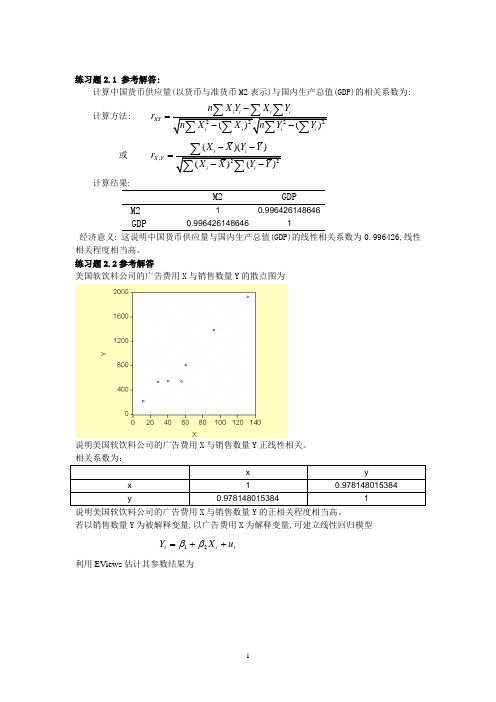
练习题2.1 参考解答:计算中国货币供应量(以货币与准货币M2表示)与国内生产总值(GDP)的相关系数为:计算方法: XY n X Y X Y r -=或,()()X Y X X Y Y r --=计算结果:M2GDPM2 10.996426148646GDP0.9964261486461经济意义: 这说明中国货币供应量与国内生产总值(GDP)的线性相关系数为0.996426,线性相关程度相当高。
练习题2.2参考解答美国软饮料公司的广告费用X 与销售数量Y 的散点图为说明美国软饮料公司的广告费用X 与销售数量Y 正线性相关。
相关系数为:说明美国软饮料公司的广告费用X 与销售数量Y 的正相关程度相当高。
若以销售数量Y 为被解释变量,以广告费用X 为解释变量,可建立线性回归模型 i i i u X Y ++=21ββ 利用EViews 估计其参数结果为经t 检验表明, 广告费用X 对美国软饮料公司的销售数量Y 确有显著影响。
回归结果表明,广告费用X 每增加1百万美元, 平均说来软饮料公司的销售数量将增加14.40359(百万箱)。
练习题2.3参考解答: 1、 建立深圳地方预算内财政收入对GDP 的回归模型,建立EViews 文件,利用地方预算内财政收入(Y )和GDP 的数据表,作散点图可看出地方预算内财政收入(Y )和GDP 的关系近似直线关系,可建立线性回归模型: t t t u GDP Y ++=21ββ 利用EViews 估计其参数结果为即 ˆ20.46110.0850t tY GDP =+ (9.8674) (0.0033)t=(2.0736) (26.1038) R 2=0.9771 F=681.4064经检验说明,深圳市的GDP 对地方财政收入确有显著影响。
20.9771R =,说明GDP 解释了地方财政收入变动的近98%,模型拟合程度较好。
模型说明当GDP 每增长1亿元时,平均说来地方财政收入将增长0.0850亿元。
计量经济学》第三版靳庭良章课后题答案
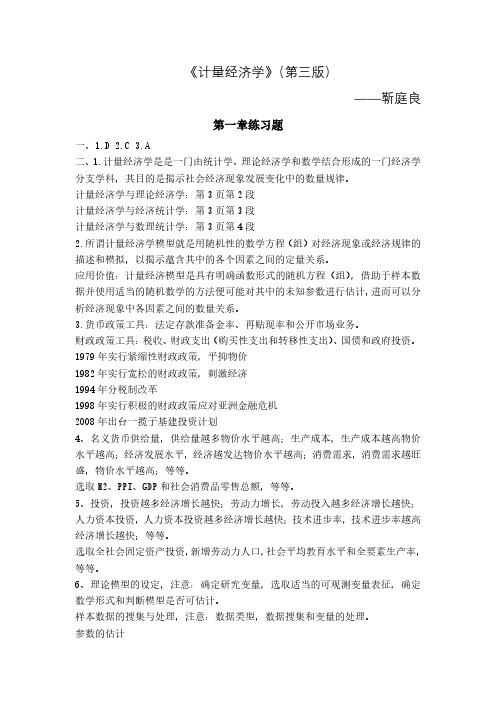
没有落在拒绝域,不能拒绝0 : 0 = 0(在 95%的置信度下)
t=
1 的t检验如下:
0 : 1 = 0
1 : 1 ≠ 0
1 − 0
= 3.244718 > 0.025(60−1−1) = 2
(1 )
落在拒绝域,拒绝0 : 1 = 0(在 95%的置信度下)认为1显著不为 0.
7、模型的简约原则是指,在其他情况相同的条件下,简单模型优于复杂模型。
详见第 15 页(5)
三、(1)ln(Y ^ ) = 0.5 + 0.86 ln(X) + 0.22Z
保持 Z 不变,微分得
= 0.86
1000
= 0.86 = 0.86 ∗
= 0.43
2000
X 对 Y 边际影响为 0.43
18
20
能。
X
(2)年龄、从业时间、智商和体能,等等。
(3)OLS回归得:
0 = −8042.643
1 = 1803.515
经济意义检验:0 至少为0,不符合经济意义;1 >0,符合经济意义。
0 的t检验如下:
0 : 0 = 0
1 : 0 ≠ 0
0 − 0
= −1.073 < 0.025(60−1−1) = 2
选取全社会固定资产投资,新增劳动力人口,社会平均教育水平和全要素生产率,
等等。
6、理论模型的设定,注意:确定研究变量,选取适当的可观测变量表征,确定
数学形式和判断模型是否可估计。
样本数据的搜集与处理,注意:数据类型,数据搜集和变量的处理。
参数的估计
模型的检验,,注意:经济意义检验、模型假定检验和统计检验。
《计量经济学教程(第二版)》习题解答课后习题答案
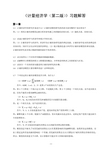
《计量经济学(第二版)》习题解答第一章1.1 计量经济学的研究任务是什么?计量经济模型研究的经济关系有哪两个基本特征? 答:(1)利用计量经济模型定量分析经济变量之间的随机因果关系。
(2)随机关系、因果关系。
1.2 试述计量经济学与经济学和统计学的关系。
答:(1)计量经济学与经济学:经济学为计量经济研究提供理论依据,计量经济学是对经济理论的具体应用,同时可以实证和发展经济理论。
(2)统计数据是建立和评价计量经济模型的事实依据,计量经济研究是对统计数据资源的深层开发和利用。
1.3 试分别举出三个时间序列数据和横截面数据。
1.4 试解释单方程模型和联立方程模型的概念,并举例说明两者之间的联系与区别。
1.5 试结合一个具体经济问题说明计量经济研究的步骤。
1.6 计量经济模型主要有哪些用途?试举例说明。
1.7 下列设定的计量经济模型是否合理,为什么?(1)ε++=∑=31i iiGDP b a GDPε++=3bGDP a GDP其中,GDP i (i =1,2,3)是第i 产业的国内生产总值。
答:第1个方程是一个统计定义方程,不是随机方程;第2个方程是一个相关关系,而不是因果关系,因为不能用分量来解释总量的变化。
(2)ε++=21bS a S其中,S 1、S 2分别为农村居民和城镇居民年末储蓄存款余额。
答:是一个相关关系,而不是因果关系。
(3)ε+++=t t t L b I b a Y 21其中,Y 、I 、L 分别是建筑业产值、建筑业固定资产投资和职工人数。
答:解释变量I 不合理,根据生产函数要求,资本变量应该是总资本,而固定资产投资只能反映当年的新增资本。
(4)ε++=t t bP a Y其中,Y 、P 分别是居民耐用消费品支出和耐用消费品物价指数。
答:模型设定中缺失了对居民耐用消费品支出有重要影响的其他解释变量。
按照所设定的模型,实际上假定这些其他变量的影响是一个常量,居民耐用消费品支出主要取决于耐用消费品价格的变化;所以,模型的经济意义不合理,估计参数时可能会夸大价格因素的影响。
计量经济学课后答案
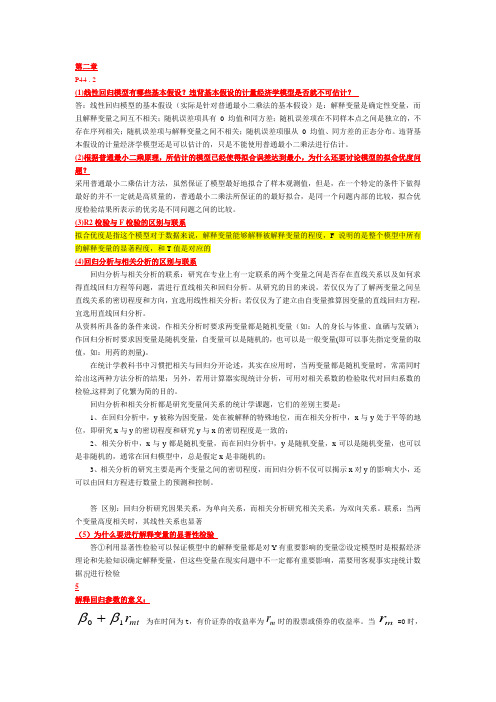
第二章P44 . 2(1)线性回归模型有哪些基本假设?违背基本假设的计量经济学模型是否就不可估计?答:线性回归模型的基本假设(实际是针对普通最小二乘法的基本假设)是:解释变量是确定性变量,而且解释变量之间互不相关;随机误差项具有 0 均值和同方差;随机误差项在不同样本点之间是独立的,不存在序列相关;随机误差项与解释变量之间不相关;随机误差项服从 0 均值、同方差的正态分布。
违背基本假设的计量经济学模型还是可以估计的,只是不能使用普通最小二乘法进行估计。
(2)根据普通最小二乘原理,所估计的模型已经使得拟合误差达到最小,为什么还要讨论模型的拟合优度问题?采用普通最小二乘估计方法,虽然保证了模型最好地拟合了样本观测值,但是,在一个特定的条件下做得最好的并不一定就是高质量的,普通最小二乘法所保证的的最好拟合,是同一个问题内部的比较,拟合优度检验结果所表示的优劣是不同问题之间的比较。
(3)R2检验与F 检验的区别与联系拟合优度是指这个模型对于数据来说,解释变量能够解释被解释变量的程度,F 说明的是整个模型中所有的解释变量的显著程度,和T 值是对应的 (4)回归分析与相关分析的区别与联系回归分析与相关分析的联系:研究在专业上有一定联系的两个变量之间是否存在直线关系以及如何求得直线回归方程等问题,需进行直线相关和回归分析。
从研究的目的来说,若仅仅为了了解两变量之间呈直线关系的密切程度和方向,宜选用线性相关分析;若仅仅为了建立由自变量推算因变量的直线回归方程,宜选用直线回归分析。
从资料所具备的条件来说,作相关分析时要求两变量都是随机变量(如:人的身长与体重、血硒与发硒);作回归分析时要求因变量是随机变量,自变量可以是随机的,也可以是一般变量(即可以事先指定变量的取值,如:用药的剂量)。
在统计学教科书中习惯把相关与回归分开论述,其实在应用时,当两变量都是随机变量时,常需同时给出这两种方法分析的结果;另外,若用计算器实现统计分析,可用对相关系数的检验取代对回归系数的检验,这样到了化繁为简的目的。
《计量经济学》(第三版)课后习题答案

《计量经济学》(第三版)课后习题答案第二章简单线性回归模型2.1(1)①首先分析人均寿命与人均GDP的数量关系,用Eviews分析:Dependent Variable: Y Method: Least SquaresDate: 12/23/15 Time: 14:37Sample: 1 22Included observations: 22Variable Coefficient Std. Error t-Statistic Prob.C 56.64794 1.960820 28.88992 0.0000X1 0.128360 0.027242 4.711834 0.0001R-squared 0.526082 Mean dependent var 62.50000 Adjusted R-squared 0.502386 S.D. dependent var 10.08889 S.E. of regression 7.116881 Akaike info criterion 6.849324 Sum squared resid 1013.000 Schwarz criterion 6.948510 Log likelihood -73.34257 Hannan-Quinn criter. 6.872689 F-statistic 22.20138 Durbin-Watson stat 0.629074 Prob(F-statistic) 0.000134有上可知,关系式为y=56.64794+0.128360x1②关于人均寿命与成人识字率的关系,用Eviews分析如下:Dependent Variable: Y Method: Least SquaresDate: 12/23/15 Time: 15:01Sample: 1 22Included observations: 22Variable Coefficient Std. Error t-Statistic Prob.C 38.79424 3.532079 10.98340 0.0000X2 0.331971 0.046656 7.115308 0.0000R-squared 0.716825 Mean dependent var 62.50000 Adjusted R-squared 0.702666 S.D. dependent var 10.08889 S.E. of regression 5.501306 Akaike info criterion 6.334356 Sum squared resid 605.2873 Schwarz criterion 6.433542 Log likelihood -67.67792 Hannan-Quinn criter. 6.357721 F-statistic 50.62761 Durbin-Watson stat 1.846406 Prob(F-statistic) 0.000001由上可知,关系式为y=38.79424+0.331971x2③关于人均寿命与一岁儿童疫苗接种率的关系,用Eviews分析如下:Dependent Variable: YMethod: Least SquaresDate: 12/23/14 Time: 15:20Sample: 1 22Included observations: 22Variable Coefficient Std. Error t-Statistic Prob.C 31.79956 6.536434 4.864971 0.0001X3 0.387276 0.080260 4.825285 0.0001R-squared 0.537929 Mean dependent var 62.50000Adjusted R-squared 0.514825 S.D. dependent var 10.08889S.E. of regression 7.027364 Akaike info criterion 6.824009Sum squared resid 987.6770 Schwarz criterion 6.923194Log likelihood -73.06409 Hannan-Quinn criter. 6.847374F-statistic 23.28338 Durbin-Watson stat 0.952555Prob(F-statistic) 0.000103由上可知,关系式为y=31.79956+0.387276x3(2)①关于人均寿命与人均GDP模型,由上可知,可决系数为0.526082,说明所建模型整体上对样本数据拟合较好。
计量经济学课后答案

计量经济学课后答案(总15页)--本页仅作为文档封面,使用时请直接删除即可----内页可以根据需求调整合适字体及大小--思考与练习1. 随机误差项u包括哪些内容2. 一元线性回归模型有哪些基本假定3.证明公式()、公式()。
4.理解样本决定系数的含义。
5.若我们搜集两个变量的历史资料如下:(1)绘制散点图;(2)x与y之间是否大致呈线性关系(3)用最小二乘法求出回归方程;(4)求回归标准误差ˆ ;(5)给出回归系数的置信度为95%的区间估计;(6)给出回归方程的方差分解表;(7)计算x与y的决定系数;(8)对回归方程进行F检验。
6.美国各航空公司业绩的统计数据公布在《华尔街日报1999年年鉴》(The Wall Street Journal Almanac 1999)上。
航班正点到达的比率和每10万名乘客投诉的次数的数据如下。
资料来源:(美)David 等《商务与经济统计》,第405页,机械工业出版社。
(1)求出描述投诉率是如何依赖航班按时到达正点率的的回归方程,并进行显著性检验。
(2)对估计的回归方程的斜率作出解释。
(3)如果航班按时到达的正点率为80%,估计每10万名乘客投诉的次数是多少7.下面是对某个案例分析的EViews输出结果。
该案例的回归分析结果是否理想为什么Dependent Variable: YMethod: Least SquaresDate: 05/28/03 Time: 10:25Sample: 1991 2000XAdjusted R-squared . dependent var. of regression Akaike info criterionSum squared resid Schwarz criterionLog likelihoodF-statisticDurbin-Watson statProb(F-statistic)1. 解:一般说来,随机项u 来自以下几个方面:(1)变量的省略。
计量经济学 课后答案
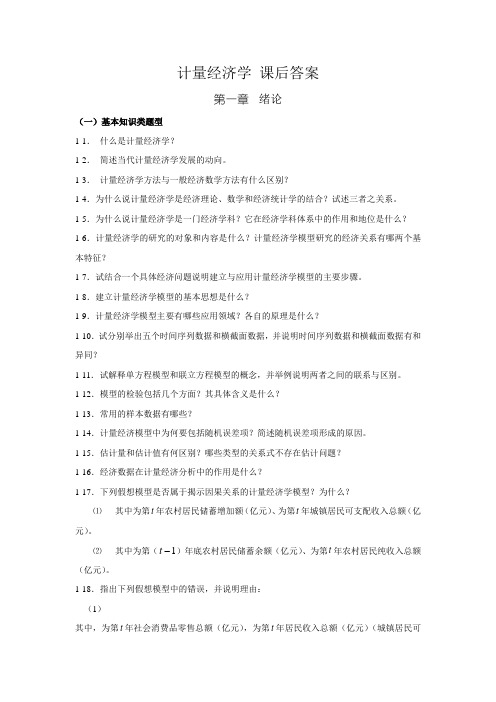
习题参考答案
第一章绪论
1-1.答:计量经济学是经济学的一个分支学科,是以揭示经济活动中客观存在的数量关系为内容的分支学科,是由经济学、统计学和数学三者结合而成的交叉学科。
1-2.答:计量经济学自20年代末、30年代初形成以来,无论在技术方法还是在应用方面发展都十分迅速,尤其是经过50年代的发展阶段和60年代的扩张阶段,使其在经济学科占据重要的地位,主要表现在:①在西方大多数大学和学院中,计量经济学的讲授已成为经济学课程表中有权威的一部分;②从1969~2003年诺贝尔经济学奖的XX位获奖者中有XX位是与研究和应用计量经济学有关;著名经济学家、诺贝尔经济学奖获得者萨缪尔森甚至说:“第二次世界大战后的经济学是计量经济学的时代”。③计量经济学方法与其他经济数学方法结合应用得到发展;④计量经济学方法从主要用于经济预测转向经济理论假设和政策假设的检验;⑤计量经济学模型的应用从传统的领域转向新的领域,如货币、工资、就业、福利、国际贸易等;⑥计量经济学模型的规模不再是水平高低的衡量标准,人们更喜欢建立一些简单的模型,从总量上、趋势上说明经济现象。
1-3.答:计量经济学方法揭示经济活动中各个因素之间的定量关系,用随机性的数学方程加以描述;一般经济数学方法揭示经济活动中各个因素之间的理论关系,用确定性的数学方程加以描述。
1-4.答:
1-5.答:从计量经济学的定义看,它是定量化的经济学;其次,从计量经济学在西方国家经济学科中居于最重要的地位看,也是如此,尤其是从诺贝尔经济学奖设立之日起,已有多人因直接或间接对计量经济学的创立和发展作出贡献而获得诺贝尔经济学奖;计量经济学与数理统计学有严格的区别,它仅限于经济领域;从建立与应用计量经济学模型的全过程看,不论是理论模型的设定还是样本数据的收集,都必须以对经济理论、对所研究的经济现象有透彻的认识为基础。综上所述,计量经济学确实是一门经济学科。
计量经济学 第二版 课后习题1-14章 中文版答案汇总
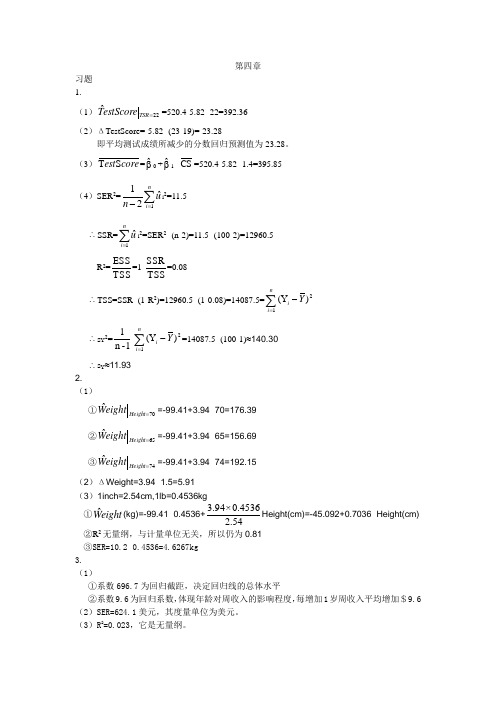
习题
1.
(1) =520.4-5.82×22=392.36
(2)ΔTestScore=-5.82×(23-19)=-23.28
即平均测试成绩所减少的分数回归预测值为23.28。
(3) = 0+ 1× =520.4-5.82×1.4=395.85
(4)SER2= i2=11.5
SSR= i2=SER2×(n-2)=11.5×(100-2)=12960.5
Var(R-Rf)=Var[β(Rm-Rf)+u]=β2×Var(Rm-Rf)+Var(u)+2β×cov(u,Rm-Rf)
cov(u,Rm-Rf)=0,Var(u) 0
Var(R-Rf) β2×Var(Rm-Rf)>Var(Rm-Rf)
(2)有可能。
Var(R-Rf)=β2×Var(Rm-Rf)+Var(u) Var(R-Rf)-Var(Rm-Rf)=(β2-1)Var(Rm-Rf)+Var(u)
②Wal-Mart: =0.65 =0.65×3.8%=2.47%
③Waste Management: =0.7 =0.7×3.8%=2.66%
④Spring Nextel: =0.78 =0.78×3.8%=2.964%
⑤Barns and Noble: =1.02 =1.02×3.8%=3.876%
R2= =1- =0.08
TSS=SSR÷(1-R2)=12960.5÷(1-0.08)=14087.5=
sY2= =14087.5÷(100-1)≈140.30
sY≈11.93
2.
(1)
① =-99.41+3.94×70=176.39
② =-99.41+3.94×65=156.69
计量经济学课后题答案
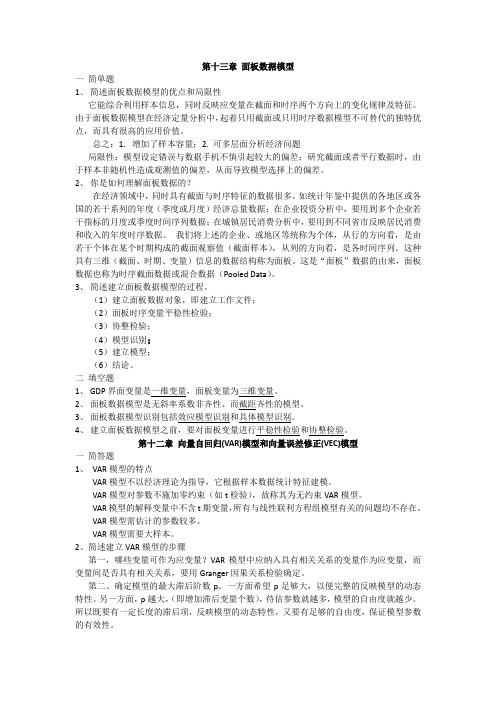
第十三章面板数据模型一简单题1、简述面板数据模型的优点和局限性它能综合利用样本信息,同时反映应变量在截面和时序两个方向上的变化规律及特征。
由于面板数据模型在经济定量分析中,起着只用截面或只用时序数据模型不可替代的独特优点,而具有很高的应用价值。
总之:1.增加了样本容量;2. 可多层面分析经济问题局限性:模型设定错误与数据手机不慎引起较大的偏差;研究截面或者平行数据时,由于样本非随机性造成观测值的偏差,从而导致模型选择上的偏差。
2、你是如何理解面板数据的?在经济领域中,同时具有截面与时序特征的数据很多。
如统计年鉴中提供的各地区或各国的若干系列的年度(季度或月度)经济总量数据;在企业投资分析中,要用到多个企业若干指标的月度或季度时间序列数据;在城镇居民消费分析中,要用到不同省市反映居民消费和收入的年度时序数据。
我们将上述的企业、或地区等统称为个体,从行的方向看,是由若干个体在某个时期构成的截面观察值(截面样本),从列的方向看,是各时间序列。
这种具有三维(截面、时期、变量)信息的数据结构称为面板。
这是“面板”数据的由来,面板数据也称为时序截面数据或混合数据(Pooled Data)。
3、简述建立面板数据模型的过程。
(1)建立面板数据对象,即建立工作文件;(2)面板时序变量平稳性检验;(3)协整检验;(4)模型识别;(5)建立模型;(6)结论。
二填空题1、GDP界面变量是一维变量,面板变量为三维变量。
2、面板数据模型是无斜率系数非齐性、而截距齐性的模型。
3、面板数据模型识别包括效应模型识别和具体模型识别。
4、建立面板数据模型之前,要对面板变量进行平稳性检验和协整检验。
第十二章向量自回归(VAR)模型和向量误差修正(VEC)模型一简答题1、VAR模型的特点VAR模型不以经济理论为指导,它根据样本数据统计特征建模。
VAR模型对参数不施加零约束(如t检验),故称其为无约束VAR模型。
VAR模型的解释变量中不含t期变量,所有与线性联利方程组模型有关的问题均不存在。
计量经济学的课后习题答案

计量经济学的课后习题答案计量经济学的课后习题答案计量经济学是经济学中的一个重要分支,它运用数理统计学和经济理论的方法来研究经济现象。
在学习计量经济学的过程中,课后习题是巩固知识和提高能力的重要途径。
下面将为大家提供一些计量经济学的课后习题答案,希望对大家的学习有所帮助。
第一题:回归分析假设我们有一个简单的线性回归模型:Y = β0 + β1X + ε,其中Y表示因变量,X表示自变量,β0和β1是回归系数,ε是误差项。
我们通过最小二乘法估计得到的回归方程为Y = 2 + 3X。
根据这个回归方程,当X等于5时,预测Y的值是多少?答案:根据回归方程,当X等于5时,预测Y的值为2 + 3*5 = 17。
第二题:假设检验在计量经济学中,假设检验是一种常用的统计方法,用于检验某个经济理论或假设是否成立。
假设我们有一个假设H0:β1 = 0,即自变量X对因变量Y没有显著影响。
我们通过回归分析得到的t统计量为2.5,自由度为50。
在显著性水平为0.05的条件下,我们应该接受还是拒绝这个假设?答案:在显著性水平为0.05的条件下,自由度为50的t分布的临界值为1.96。
由于t统计量的值(2.5)大于临界值(1.96),我们可以拒绝假设H0,即自变量X对因变量Y有显著影响。
第三题:多元回归分析多元回归分析是计量经济学中常用的分析方法之一,它考虑了多个自变量对因变量的影响。
假设我们有一个多元回归模型:Y = β0 + β1X1 + β2X2 + ε,其中Y表示因变量,X1和X2表示两个自变量,β0、β1和β2是回归系数,ε是误差项。
我们通过最小二乘法估计得到的回归方程为Y = 1 + 2X1 + 3X2。
根据这个回归方程,当X1等于3,X2等于4时,预测Y的值是多少?答案:根据回归方程,当X1等于3,X2等于4时,预测Y的值为1 + 2*3 +3*4 = 19。
第四题:异方差问题在计量经济学中,异方差是指误差项的方差不恒定,而是与自变量的取值相关。
计量经济学习题及全部答案

计量经济学习题及全部答案Newly compiled on November 23, 2020《计量经济学》习题(一)一、判断正误1.在研究经济变量之间的非确定性关系时,回归分析是唯一可用的分析方法。
( ) 2.最小二乘法进行参数估计的基本原理是使残差平方和最小。
( )3.无论回归模型中包括多少个解释变量,总离差平方和的自由度总为(n -1)。
( ) 4.当我们说估计的回归系数在统计上是显着的,意思是说它显着地异于0。
( ) 5.总离差平方和(TSS )可分解为残差平方和(ESS )与回归平方和(RSS )之和,其中残差平方和(ESS )表示总离差平方和中可由样本回归直线解释的部分。
( ) 6.多元线性回归模型的F 检验和t 检验是一致的。
( )7.当存在严重的多重共线性时,普通最小二乘估计往往会低估参数估计量的方差。
( )8.如果随机误差项的方差随解释变量变化而变化,则线性回归模型存在随机误差项的自相关。
( )9.在存在异方差的情况下,会对回归模型的正确建立和统计推断带来严重后果。
( ) 10...DW 检验只能检验一阶自相关。
( ) 二、单选题1.样本回归函数(方程)的表达式为( )。
A .i Y =01i i X u ββ++B .(/)i E Y X =01i X ββ+C .i Y =01ˆˆi i X e ββ++D .ˆi Y =01ˆˆi X ββ+ 2.下图中“{”所指的距离是( )。
A .随机干扰项B .残差C .i Y 的离差D .ˆi Y 的离差 3.在总体回归方程(/)E Y X =01X ββ+中,1β表示( )。
A .当X 增加一个单位时,Y 增加1β个单位B .当X 增加一个单位时,Y 平均增加1β个单位C .当Y 增加一个单位时,X 增加1β个单位D .当Y 增加一个单位时,X 平均增加1β个单位 4.可决系数2R 是指( )。
A .剩余平方和占总离差平方和的比重B .总离差平方和占回归平方和的比重C .回归平方和占总离差平方和的比重D .回归平方和占剩余平方和的比重 5.已知含有截距项的三元线性回归模型估计的残差平方和为2i e ∑=800,估计用的样本容量为24,则随机误差项i u 的方差估计量为( )。
《计量经济学》第三版课后题答案李子奈

第一章绪论之阳早格格创做参照沉面:计量经济教的普遍建模历程第一章课后题(1.4.5)1.什么是计量经济教?计量经济教要领与普遍经济数教要领有什么辨别?问:计量经济教是经济教的一个分支教科,是以掀穿经济活动中客瞅存留的数量闭系为真量的分支教科,是由经济教、统计教战数教三者分离而成的接叉教科.计量经济教要领掀穿经济活动中各个果素之间的定量闭系,用随机性的数教圆程加以形貌;普遍经济数教要领掀穿经济活动中各个果素之间的表里闭系,用决定性的数教圆程加以形貌.4.建坐与应用计量经济教模型的主要步调有哪些?问:建坐与应用计量经济教模型的主要步调如下:(1)设定表里模型,包罗采用模型所包罗的变量,决定变量之间的数教闭系战拟定模型中待估参数的数值范畴;(2)支集样本数据,要思量样本数据的完备性、准确性、可比性战—致性;(3)预计模型参数;(4)考验模型,包罗经济意思考验、统计考验、计量经济教考验战模型预测考验.5.模型的考验包罗几个圆里?其简曲含意是什么?问:模型的考验主要包罗:经济意思考验、统计考验、计量经济教考验、模型的预测考验.正在经济意思考验中,需要考验模型是可切合经济意思,考验供得的参数预计值的标记与大小是可与根据人们的体味战经济表里所拟订的憧憬值相切合;正在统计考验中,需要考验模型参数预计值的稳当性,即考验模型的统计教本量;正在计量经济教考验中,需要考验模型的计量经济教本量,包罗随机扰动项的序列相闭考验、同圆好性考验、阐明变量的多沉共线性考验等;模型的预测考验主要考验模型参数预计量的宁静性以及对付样本容量变更时的敏捷度,以决定所建坐的模型是可不妨用于样本瞅测值以中的范畴.第二章典范单圆程计量经济教模型:一元线性返回模型参照沉面:1.相闭分解与返回分解的观念、通联以及辨别?2.总体随机项与样本随机项的辨别与通联?3.为什么需要举止拟合劣度考验?4.怎么样缩小置疑区间?(P46)由上式不妨瞅出(1).删大样本容量.样本容量变大,可使样本参数预计量的尺度好减小;共时,正在共样置疑火仄下,n越大,t分散表中的临界值越小.(2)普及模型的拟合劣度.果为样本参数预计量的尺度好战残好仄圆战呈正比,模型的拟合劣度越下,残好仄圆战应越小.5.以一元线性返回为例,写出β0的假设考验1).对付总体参数提出假设H0:b0=0,H1:b0¹02)以本假设H0构制t统计量,3)由样本预计其值4)给定隐著性火仄a,查t分散表得临界值t a/2(n-2)5)比较,推断若|t|> t a/2(n-2),则中断H0,担当H1;若|t|£ t a/2(n-2),则中断H1,担当H0;上届沉面:一元线性返回模型的基础假设、随机缺面项爆收的本果、最小二乘法、参数经济意思、决断系数、第二章PPT 里的表(华夏住户人均消耗开销对付人均GDP的返回)、t 考验(△(仄圆)代表意思;△(仄圆)的认识)、不妨读懂Eviews输出的预计截止第二章课后题(1.3.9.10)1.为什么计量经济教模型的表里圆程中必须包罗随机搞扰项?(典范模型中爆收随机缺面的本果)问:计量经济教模型观察的是具备果果闭系的随机变量间的简曲通联办法.由于是随机变量,表示着效率被阐明变量的果素是搀纯的,除了阐明变量的效率中,另有其余无法正在模型中独力列出的百般果素的效率.那样,表里模型中便必须使用一个称为随机搞扰项的变量宋代表所有那些无法正在模型中独力表示出去的效率果素,以包管模型正在表里上的科教性.3.一元线性返回模型的基础假设主要有哪些?违背基础假设的模型是可不不妨预计?问:线性返回模型的基础假设有二大类:一类是闭于随机搞扰项的,包罗整均值,共圆好,不序列相闭,谦脚正态分散等假设;另一类是闭于阐明变量的,主要有:阐明变量利害随机的,假如随机变量,则与随机搞扰项不相闭.本量上,那些假设皆是针对付一般最小二乘法的.正在违背那些基础假设的情况下,一般最小二乘预计量便不再是最好线性无偏偏预计量,果此使用一般最小二乘法举止预计己无多大意思.但是模型自己仍旧不妨预计的,越收是不妨通过最大似然法等其余本理举止预计.假设1. 阐明变量X是决定性变量,不是随机变量;假设2. 随机缺面项m具备整均值、共圆好战不序列相闭性:E(m i)=0i=1,2, …,nVar (m i)=s m2 i=1,2, …,nCov(m i, m j)=0i≠j i,j= 1,2, …,n假设3. 随机缺面项m与阐明变量X之间不相闭:Cov(X i, m i)=0 i=1,2, …,n假设4.m遵循整均值、共圆好、整协圆好的正态分散m i~N(0, sm2) i=1,2, …,n假设5. 随着样本容量的无限减少,阐明变量X的样本圆好趋于一有限常数.即假设6. 返回模型是精确设定的9、10题为预计题,睹课本P52,问案睹P17第三章典范单圆程计量经济教模型:多元线性返回模型上届沉面:F考验、t考验安排的样本决断系数、“多元”里为什么要对付△(仄圆)系数举止安排?第三章课后题(1.2.7.9.10)1.多元线性返回模型的基础假设是什么?正在道明最小二乘预计量的无偏偏性战灵验性的历程中,哪些基础假设起了效率?问:多元线性返回模型的基础假定仍旧是针对付随机搞扰项与针对付阐明变量二大类的假设.针对付随机搞扰项的假设有:整均值,共圆好,无序列相闭且遵循正态分散.针对付阐明量的假设有;阐明变量应具备非随机性,如果后随机的,则不克不迭与随机搞扰项相闭;各阐明变量之间不存留(真足)线性相闭闭系.正在道明最小二乘预计量的无偏偏性中,利用了阐明变量非随机大概与随机搞扰项不相闭的假定;正在灵验性的道明中,利用了随机搞扰项共圆好且无序列相闭的假定.2.正在多元线性返回分解中,t考验战F考验有何分歧?正在一元线性返回分解中二者是可有等价效率?(睹课本P70)问:正在多元线性返回分解中,t考验常被用做考验返回圆程中各个参数的隐著性,而F考验则被用做考验所有返回闭系的隐著性.各阐明变量共同起去对付被阐明变量有隐著的线性闭系,本去不料味着每一个阐明变量分别对付被阐明变量有隐著的线性闭系.正在一元线性返回分解中,二者具备等价效率,果为二者皆是对付共共的假设——阐明变量的参数等于整一一举止考验.7、9、10题为预计题,睹课本P91,问案睹P53第四章典范单圆程计量经济教模型:搁宽基础假定的模型沉面掌握:参照沉面:1.以多元线性返回为例道明同圆好性会爆收何如的成果?(大概为叙述题)2.考验、建正同圆好性的要领?3.以多元线性返回为例道明序列相闭会爆收何如的成果?(预测,矩阵表白式推到)4.考验、建正序列相闭的要领?5.什么是DW考验法(前提条件)?7.考验、建正多沉共线性的要领?8.随机阐明变量问题的三种分类?分别制成的成果是什么?1)与所代替的随机阐明变量下度相闭2)与随机搞扰项不相闭3)与模型中其余阐明变量不相闭,以预防出现多沉共线性上届沉面:同圆好、序列相闭、多沉共线性等违背基础假设的情况爆收本果、成果、辨别办法要领、D.W、广义好分法第四章课后题(1.2)1、2题为预计题,睹课本P134,问案睹P84第五章典范单圆程计量经济教模型:博门问题上届沉面:假制变量的含意与设定、滞后变量的含意、为何加进滞后战假制变量第五章课后题(1.3.4.10)1.返回模型中引进假制变量的效率是什么?有哪几种基础的引进办法?它们各切合用于什么情况?问:正在模型中引进假制变量,主假如为了觅找某(些)定性果素对付阐明变量的效率.加法办法与乘法办法是最主要的引进办法.前者主要适用于定性果素对付截距项爆收效率的情况,后者主要适用于定性果素对付斜率项爆收效率的情况.除别的,还不妨加法与乘法拉拢的办法引进假制变量,那时可测度定性果素对付截距项与斜率项共时爆收效率的情况.3.滞后变量模型有哪几种典型?分散滞后模型使用OLS要领存留哪些问题?问:滞后变量模型有分散滞后模型战自返回模型二大类,前者惟有阐明变量及其滞后变量动做模型的阐明变量,不包罗被阐明变量的滞后变量动做模型的阐明变量;而后者则以当期阐明变量与被阐明变量的若搞期滞后变量动做模型的阐明变量.分散滞后模型有无克日的分散滞后模型战有克日的分散滞后模型;自返回模型又以Coyck模型、自切合预期模型战局部安排模型最为多睹.分散滞后模型使用OLS法存留以下问题:(1)对付于无克日的分散滞后模型,由于样本瞅测值的有限性,使得无法间接对付其举止预计.(2)对付于有克日的分散滞后模型,使用OLS要领会逢到:不先验规则决定滞后期少度,对付最大滞后期的决定往往戴有主瞅随意性;如果滞后期较少,由于样本容量有限,当滞后变量数目减少时,必定使得自由度缩小,将缺累脚够的自由度举止预计战考验;共名变量滞后值之间大概存留下度线性相闭,即模型大概存留下度的多沉共线性.4.爆收模型设定偏偏误的主要本果是什么?模型设定偏偏误的成果以及考验要领有哪些?问:爆收模型设定偏偏误的本果主要有:模型制定者不认识相映的表里知识;对付经济问题自己认识不敷大概不认识前人的相闭处事:模型制定者脚头不相闭变量的数据;阐明变量无法丈量大概数据自己存留丈量缺面.模型设定偏偏误的成果有:(1)如果遗漏了要害的阐明变量,会制成OLS预计量正在小样本下有偏偏,正在大样本下非普遍;对付随机搞扰项的圆好预计也是有偏偏的.(2)如果包罗了无闭的阐明变量,纵然OLS预计量具备无偏偏性与普遍性,但是不具备最小圆好性.(3)如果采用了过失的函数形式,则成果是齐圆背的,不但会制成预计的参数具备真足分歧的经济意思,而且预计截止也分歧.对付模型设定偏偏误的考验要领有:考验是可含有无闭变量,不妨使用t考验与F考验完毕:考验是可有相闭变量的遗漏大概函数形式设定偏偏误,不妨使用残好图示法,Ramsey提出的RESET考验去完毕.10.简述约化建模表里与保守表里的同共面?问:Hendry的约化建模表里的核心是“从普遍到简朴”的建模思维,即最先提出一个包罗百般果素正在内的“普遍”模型,而后再通过瞅测数据,利用百般考验对付模型举止考验并化简,末尾得到一个相对付简朴的模型.保守建模表里的主宰思维是“从简朴到搀纯”的建模思维,它最先提出一个简朴的模型,而后从百般大概的备选变量中采用切合的变量加进模型,末尾得到一个与数据拟合较好的较为搀纯的模型.从二者的主要通联上瞅,它们皆以对付经济局里的阐明为目标,以已有的经济表里为建模依据,以对付数据的拟合程度动做模型劣劣的要害的判决尺度之一,也皆有若搞考验标推.从二者的主要辨别上瞅,保守的建模表里往往更依好于某种简朴的经济表里,旧“从普遍到简朴”的建模表里则更注沉将百般分歧经济表里纳进到最初的“普遍”模型中,以至更多天是从曲观战体味去建坐“普遍”的模型;纵然二者皆有若搞种考验尺度,但是约化建模表里从试验上有更洪量的诊疗性考验去瞅每一步建模的可止性,大概觅找革新模型的路径:与保守建模试验中存留的过度“数据启采”问题相比,由于约化建模表里的初估模型是一个包罗所有大概变量的“普遍”模型,果此也便预防了过分的“数据启采”问题;其余,由于初初模型的“普遍”性,所有钻研者正在建模的初期往往有着相共的“起面”,果此,正在相共的约化步调下,末尾得到的最后模型也该当是相共的.而保守建模试验中对付共已经济问题往往有百般分歧经济表里去阐明,如果分歧的钻研者采与分歧的经济表里建模,得到的最后模型也会分歧.天然,由于约化建模表里有更多的考验,使得建模历程更搀纯,相比之下,保守建模圆规则越收“机动”.第六章联坐圆程计量经济教模型表里与要领上届沉面:内死变量、中死变量、先定变量、结构式模型、简化式模型、参数闭系体系、模型辨别第六章课后题(1.2.3.)1.为什么要建坐联坐圆程计量经济教模型?联坐圆程计量经济教模型适用于什么样的经济局里?问:经济局里是极为搀纯的,其中诸果素之间的闭系,正在很多情况下,不是简朴圆程所能形貌的那种简朴的单背果果闭系,而是相互依存,互为果果的,那时,便必须用联坐的计量经济教圆程才搞形貌领会.所以与单圆程适用于简朴经济局里的钻研相比,联坐圆程计量经济教模型适用于形貌搀纯的经济局里,即经济系统.2.联坐圆程计量经济教模型的辨别情景不妨分为几类?其含意各是什么?问:联坐圆程计量经济教模型的辨别情景不妨分为可辨别战不可辨别,可辨别又分为恰好辨别战过分辨别.如果联坐圆程计量经济教模型中某个结构圆程不具备决定的统计形式,则称该圆程为不可辨别,大概者根据参数闭系体系,正在已知简化式参数预计值时,如果不克不迭得到联坐圆程计量经济教模型中某个结构圆程的决定的结构参数预计值,称该圆程为不可辨别.如果一个模型中的所有随机圆程皆是不妨识别的,则认为该联坐圆程计量经济教模型系统是不妨识别的.反过去,如果一个模型系统中存留一个不可识别的随机圆程,则认为该联坐圆程汁量经济教模型系统是不不妨识别的.如果某一个随机圆程具备唯一一组参数预计量,称其为恰好辨别;如果某一个随机圆程具备多组参数预计量,称其为过分辨别.3.联坐圆程计量经济教模型的单圆程预计有哪些主要要领?其适用条件战统计本量各是什么?问:单圆程预计的主要要领有:狭义的工具变量法(IV),间接最小二乘法(ILS),二阶段最小二乘法(2SLS).狭义的工具变量法(IV)战间接最小二乘法(ILS)只适用于恰好识别的结构圆程的预计.二阶段最小二乘法(2SLs)既适用于恰好识别的结构圆程,又适用于过分识别的结构圆程.用功具变量法预计的参数,普遍情况下,正在小样本下是有偏偏的,但是正在大样本下是渐近无偏偏的.如果采用的工具变量与圆程随机搞扰项真足不相闭,那么其参数预计量是无偏偏预计量.对付于间接最小二乘法,对付简化式模型应用一般最小二乘法得到的参数预计量具备线性性、无偏偏性、灵验性.通过普遍闭系体系预计得到结构圆程的结构参数预计量正在小样本下是有偏偏的,正在大样本下是渐近无偏偏的.采与二阶段最小二乘法得到结构圆程的结构参数预计量正在小样本下是有偏偏的,正在大样本下是渐近无偏偏的.补充资料预计题(一)给出多元线性返回的截止1.推断模型预计的截止怎么样,拟合效验怎么样?2.道明每一个参数所代表的经济意思?3.推断有不违背四个基础假设?预计题(二)给出数值,预计:1.t考验,F考验的自由度2.正在给定隐著性火仄下参数是可隐著?3.预计值是有偏偏、无偏偏、灵验?预计题(三)加进假制变量D1,D2,D3问:假制变量的经济含意?。
《计量经济学》第三版课后题答案

第一章绪论参考重点:计量经济学的一般建模过程第一章课后题〔1.4.5〕1.什么是计量经济学计量经济学方法与一般经济数学方法有什么区别答:计量经济学是经济学的一个分支学科,是以提醒经济活动中客观存在的数量关系为内容的分支学科,是由经济学、统计学和数学三者结合而成的穿插学科。
计量经济学方法提醒经济活动中各个因素之间的定量关系,用随机性的数学方程加以描述;一般经济数学方法提醒经济活动中各个因素之间的理论关系,用确定性的数学方程加以描述。
4.建设与应用计量经济学模型的主要步骤有哪些答:建设与应用计量经济学模型的主要步骤如下:(1)设定理论模型,包括选择模型所包含的变量,确定变量之间的数学关系和拟定模型中待估参数的数值范围;(2)收集样本数据,要考虑样本数据的完整性、准确性、可比性和—致性;(3)估计模型参数;(4)检验模型,包括经济意义检验、统计检验、计量经济学检验和模型预测检验。
5.模型的检验包括几个方面其具体含义是什么答:模型的检验主要包括:经济意义检验、统计检验、计量经济学检验、模型的预测检验。
在经济意义检验中,需要检验模型是否符合经济意义,检验求得的参数估计值的符号与大小是否与根据人们的经历和经济理论所拟订的期望值相符合;在统计检验中,需要检验模型参数估计值的可靠性,即检验模型的统计学性质;在计量经济学检验中,需要检验模型的计量经济学性质,包括随机扰动项的序列相关检验、异方差性检验、解释变量的多重共线性检验等;模型的预测检验主要检验模型参数估计量的稳定性以及对样本容量变化时的灵敏度,以确定所建设的模型是否可以用于样本观测值以外的范围。
第二章经典单方程计量经济学模型:一元线性回归模型参考重点:1.相关分析与回归分析的概念、联系以及区别2.总体随机项与样本随机项的区别与联系3.为什么需要进展拟合优度检验4.如何缩小置信区间〔P46〕由上式可以看出〔1〕.增大样本容量。
样本容量变大,可使样本参数估计量的标准差减小;同时,在同样置信水平下,n越大,t分布表中的临界值越小。
计量经济学(数字教材版)课后习题参考答案
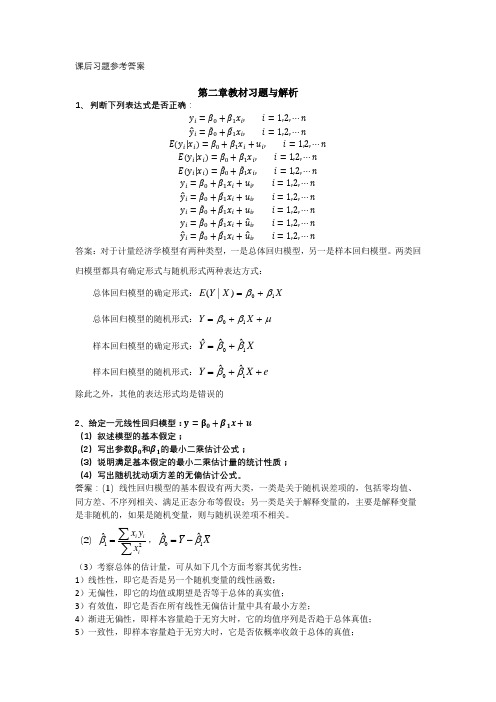
课后习题参考答案第二章教材习题与解析1、 判断下列表达式是否正确:y i =β0+β1x i ,i =1,2,⋯ny ̂i =β̂0+β̂1x i ,i =1,2,⋯nE(y i |x i )=β0+β1x i +u i ,i =1,2,⋯n E(y i |x i )=β0+β1x i ,i =1,2,⋯nE(y i |x i )=β̂0+β̂1x i ,i =1,2,⋯ny i =β0+β1x i +u i ,i =1,2,⋯ny ̂i =β̂0+β̂1x i +u i ,i =1,2,⋯n y i =β̂0+β̂1x i +u i ,i =1,2,⋯n y i =β̂0+β̂1x i +u ̂i ,i =1,2,⋯n y ̂i =β̂0+β̂1x i +u ̂i ,i =1,2,⋯n答案:对于计量经济学模型有两种类型,一是总体回归模型,另一是样本回归模型。
两类回归模型都具有确定形式与随机形式两种表达方式:总体回归模型的确定形式:X X Y E 10)|(ββ+= 总体回归模型的随机形式:μββ++=X Y 10样本回归模型的确定形式:X Y 10ˆˆˆββ+= 样本回归模型的随机形式:e X Y ++=10ˆˆββ 除此之外,其他的表达形式均是错误的2、给定一元线性回归模型:y =β0+β1x +u (1)叙述模型的基本假定;(2)写出参数β0和β1的最小二乘估计公式;(3)说明满足基本假定的最小二乘估计量的统计性质; (4)写出随机扰动项方差的无偏估计公式。
答案:(1)线性回归模型的基本假设有两大类,一类是关于随机误差项的,包括零均值、同方差、不序列相关、满足正态分布等假设;另一类是关于解释变量的,主要是解释变量是非随机的,如果是随机变量,则与随机误差项不相关。
(2)12ˆi iix yxβ=∑∑,01ˆˆY X ββ=- (3)考察总体的估计量,可从如下几个方面考察其优劣性:1)线性性,即它是否是另一个随机变量的线性函数; 2)无偏性,即它的均值或期望是否等于总体的真实值;3)有效值,即它是否在所有线性无偏估计量中具有最小方差;4)渐进无偏性,即样本容量趋于无穷大时,它的均值序列是否趋于总体真值; 5)一致性,即样本容量趋于无穷大时,它是否依概率收敛于总体的真值;6)渐进有效性,即样本容量趋于无穷大时,它在所有的一致估计量中是否具有最小的渐进方差。
计量经济学课后习题答案

第一章1.计量经济学是一门什么样的学科?答:计量经济学的英文单词是Econometrics,本意是“经济计量”,研究经济问题的计量方法,因此有时也译为“经济计量学”。
将Econometrics译为“计量经济学”是为了强调它是现代经济学的一门分支学科,不仅要研究经济问题的计量方法,还要研究经济问题发展变化的数量规律。
可以认为,计量经济学是以经济理论为指导,以经济数据为依据,以数学、统计方法为手段,通过建立、估计、检验经济模型,揭示客观经济活动中存在的随机因果关系的一门应用经济学的分支学科。
2.计量经济学与经济理论、数学、统计学的联系和区别是什么?答:计量经济学是经济理论、数学、统计学的结合,是经济学、数学、统计学的交叉学科(或边缘学科)。
计量经济学与经济学、数学、统计学的联系主要是计量经济学对这些学科的应用。
计量经济学对经济学的应用主要体现在以下几个方面:第一,计量经济学模型的选择和确定,包括对变量和经济模型的选择,需要经济学理论提供依据和思路;第二,计量经济分析中对经济模型的修改和调整,如改变函数形式、增减变量等,需要有经济理论的指导和把握;第三,计量经济分析结果的解读和应用也需要经济理论提供基础、背景和思路。
计量经济学对统计学的应用,至少有两个重要方面:一是计量经济分析所采用的数据的收集与处理、参数的估计等,需要使用统计学的方法和技术来完成;一是参数估计值、模型的预测结果的可靠性,需要使用统计方法加以分析、判断。
计量经济学对数学的应用也是多方面的,首先,对非线性函数进行线性转化的方法和技巧,是数学在计量经济学中的应用;其次,任何的参数估计归根结底都是数学运算,较复杂的参数估计方法,或者较复杂的模型的参数估计,更需要相当的数学知识和数学运算能力,另外,在计量经济理论和方法的研究方面,需要用到许多的数学知识和原理。
计量经济学与经济学、数学、统计学的区别也很明显,经济学、数学、统计学中的任何一门学科,都不能替代计量经济学,这三门学科简单地合起来,也不能替代计量经济学。
- 1、下载文档前请自行甄别文档内容的完整性,平台不提供额外的编辑、内容补充、找答案等附加服务。
- 2、"仅部分预览"的文档,不可在线预览部分如存在完整性等问题,可反馈申请退款(可完整预览的文档不适用该条件!)。
- 3、如文档侵犯您的权益,请联系客服反馈,我们会尽快为您处理(人工客服工作时间:9:00-18:30)。
CHAPTER 1TEACHING NOTESYou have substantial latitude about what to emphasize in Chapter 1. I find it useful to talk about the economics of crime example (Example 1.1) and the wage example (Example 1.2) so that students see, at the outset, that econometrics is linked to economic reasoning, even if the economics is not complicated theory.I like to familiarize students with the important data structures that empirical economists use, focusing primarily on cross-sectional and time series data sets, as these are what I cover in afirst-semester course. It is probably a good idea to mention the growing importance of data sets that have both a cross-sectional and time dimension.I spend almost an entire lecture talking about the problems inherent in drawing causal inferences in the social sciences. I do this mostly through the agricultural yield, return to education, and crime examples. These examples also contrast experimental and nonexperimental (observational) data. Students studying business and finance tend to find the term structure of interest rates example more relevant, although the issue there is testing the implication of a simple theory, as opposed to inferring causality. I have found that spending time talking about these examples, in place of a formal review of probability and statistics, is more successful (and more enjoyable for the students and me).SOLUTIONS TO PROBLEMS1.1 (i) Ideally, we could randomly assign students to classes of different sizes. That is, each student is assigned a different class size without regard to any student characteristics such as ability and family background. For reasons we will see in Chapter 2, we would like substantial variation in class sizes (subject, of course, to ethical considerations and resource constraints).(ii) A negative correlation means that larger class size is associated with lower performance. We might find a negative correlation because larger class size actually hurts performance. However, with observational data, there are other reasons we might find a negative relationship. For example, children from more affluent families might be more likely to attend schools with smaller class sizes, and affluent children generally score better on standardized tests. Another possibility is that, within a school, a principal might assign the better students to smaller classes. Or, some parents might insist their children are in the smaller classes, and these same parents tend to be more involved in their children’s education.(iii) Given the potential for confounding factors – some of which are listed in (ii) – finding a negative correlation would not be strong evidence that smaller class sizes actually lead to better performance. Some way of controlling for the confounding factors is needed, and this is the subject of multiple regression analysis.1.2 (i) Here is one way to pose the question: If two firms, say A and B, are identical in all respects except that firm A supplies job training one hour per worker more than firm B, by how much would firm A’s output differ from firm B’s?(ii) Firms are likely to choose job training depending on the characteristics of workers. Some observed characteristics are years of schooling, years in the workforce, and experience in a particular job. Firms might even discriminate based on age, gender, or race. Perhaps firms choose to offer training to more or less able workers, where “ability” might be difficult to quantify but where a manager has some idea about the relative abilities of different employees. Moreover, different kinds of workers might be attracted to firms that offer more job training on average, and this might not be evident to employers.(iii) The amount of capital and technology available to workers would also affect output. So, two firms with exactly the same kinds of employees would generally have different outputs if they use different amounts of capital or technology. The quality of managers would also have an effect.(iv) No, unless the amount of training is randomly assigned. The many factors listed in parts (ii) and (iii) can contribute to finding a positive correlation between output and training even if job training does not improve worker productivity.1.3 It does not make sense to pose the question in terms of causality. Economists would assume that students choose a mix of studying and working (and other activities, such as attending class, leisure, and sleeping) based on rational behavior, such as maximizing utility subject to the constraint that there are only 168 hours in a week. We can then use statistical methods tomeasure the association between studying and working, including regression analysis that we cover starting in Chapter 2. But we would not be claiming that one variable “causes” the other. They are both choice variables of the student.SOLUTIONS TO COMPUTER EXERCISESC1.1 (i) The average of educ is about 12.6 years. There are two people reporting zero years of education, and 19 people reporting 18 years of education.(ii) The average of wage is about $5.90, which seems low in 2005.(iii) Using Table B-60 in the 2004 Economic Report of the President, the CPI was 56.9 in 1976 and 184.0 in 2003.(iv) To convert 1976 dollars into 2003 dollars, we use the ratio of the CPIs, which is ≈. Therefore, the average hourly wage in 2003 dollars is roughly184/56.9 3.23≈, which is a reasonable figure.3.23($5.90)$19.06(v) The sample contains 252 women (the number of observations with female = 1) and 274 men.C1.2 (i) There are 1,388 observations in the sample. Tabulating the variable cigs shows that 212 women have cigs > 0.(ii) The average of cigs is about 2.09, but this includes the 1,176 women who did not smoke. Reporting just the average masks the fact that almost 85 percent of the women did not smoke. It makes more sense to say that the “typical” woman does not smoke during pregnancy; indeed, the median number of cigarettes smoked is zero.(iii) The average of cigs over the women with cigs > 0 is about 13.7. Of course this is much higher than the average over the entire sample because we are excluding 1,176 zeros.(iv) The average of fatheduc is about 13.2. There are 196 observations with a missing value for fatheduc, and those observations are necessarily excluded in computing the average.(v) The average and standard deviation of faminc are about 29.027 and 18.739, respectively, but faminc is measured in thousands of dollars. So, in dollars, the average and standard deviation are $29,027 and $18,739.C1.3 (i) The largest is 100, the smallest is 0.(ii) 38 out of 1,823, or about 2.1 percent of the sample.(iii) 17(iv) The average of math4 is about 71.9 and the average of read4 is about 60.1. So, at least in 2001, the reading test was harder to pass.(v) The sample correlation between math4 and read4 is about .843, which is a very high degree of (linear) association. Not surprisingly, schools that have high pass rates on one test have a strong tendency to have high pass rates on the other test.(vi) The average of exppp is about $5,194.87. The standard deviation is $1,091.89, which shows rather wide variation in spending per pupil. [The minimum is $1,206.88 and the maximum is $11,957.64.]。
